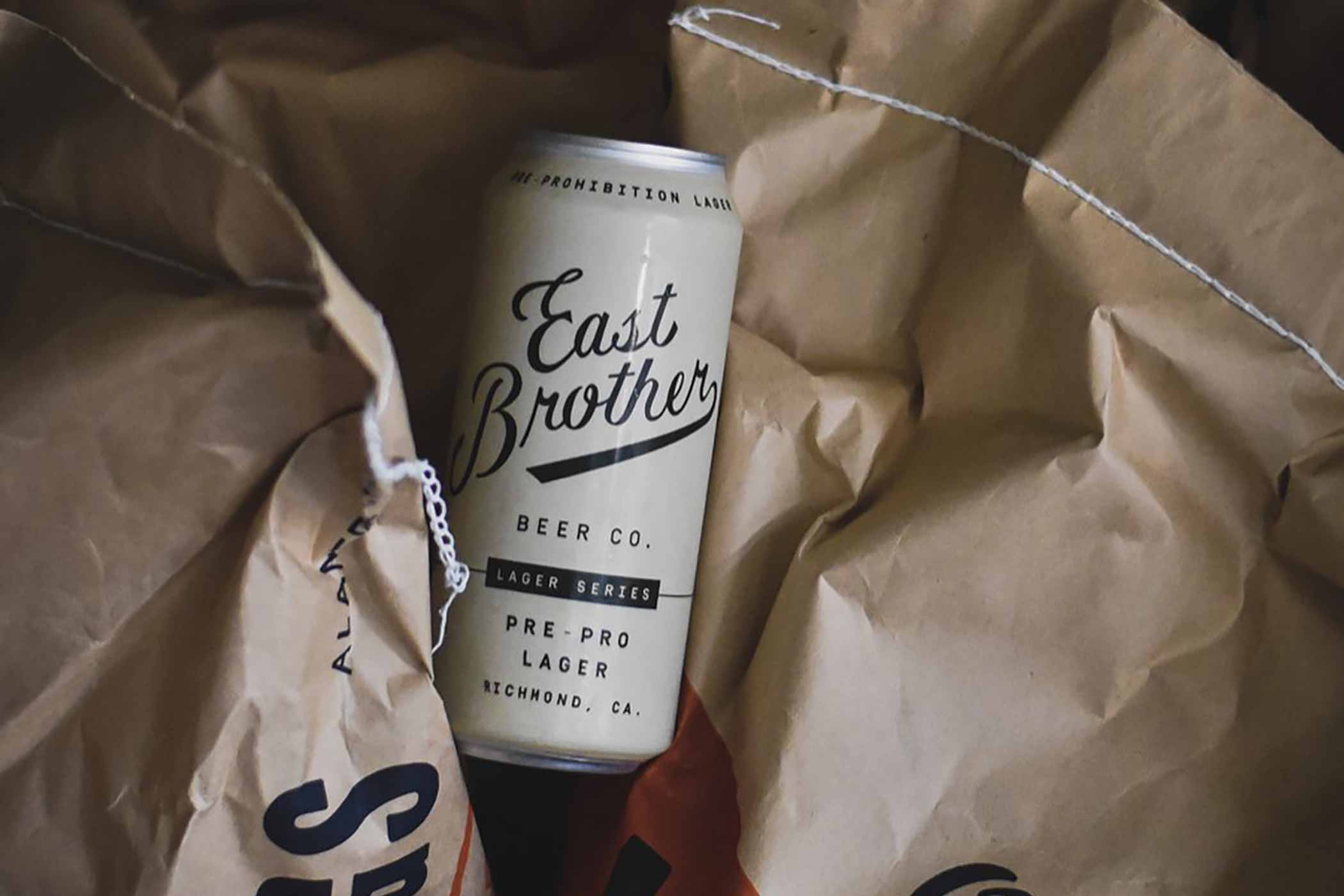Shop
We Want Beer! Back to the Future With Pre-Prohibition Lager
The 21st Amendment is the best amendment!
Looking For More Top Articles?
Ninety years ago, on December 5, 1933, something magical happened. Then-President Franklin D. Roosevelt issued the 21st Amendment, repealing alcohol prohibition in the United States. After thirteen years during which Americans couldn’t legally drink, manufacture, or sell alcohol, the new amendment released us from our self-imposed imbibing prison. Before the 18th Amendment officially sent us into a downward drinking spiral, one beer style seemed to rise above the rest: lagers. And precisely what we now call pre-Prohibition lager.
See, these aren’t your average American light lagers. Instead, pre-Pro lagers, as they’re affectionately called, capture a time and a place.
“I would describe pre-Pro lager as … paying homage to what lager might have been or was back in the early days of America,” says Goldfinger Brewing Co-Founder and Brewer Thomas Beckmann. “What were raw American lagers like?”
These lagers took parts of the brewing traditions and techniques that European immigrants brought with them, melding with ingredients available in America in the nineteenth and early twentieth centuries.
“Pre-Pro lager is the foundation of the traditional American beer we’re drinking now,” says Paul Liszewski, brewmaster at East Brother Beer in Richmond, CA, who brews the brewery’s Pre-Prohibition Lager seasonally every summer. “This is the beer they were most likely brewing before Prohibition started at a time when there were a lot of German brewers leaving the Fatherland and bringing their process and techniques and lager yeast with them, trying to replicate what they brewed at home before they left.”
With something like lager, yeast you could just “take [it] in a vial and stick [it] in your back pocket,” says Liszewski, but, “if you want to brew a batch with a specific malt and have leftover seeds, you’ll have thousands of pounds, which doesn’t pack very well.”
In other words, those early immigrant brewers couldn’t make everything exactly to a T, so they adapted, foraging what was in the amber waves of grain around them.
In this case, six-row barley, American hops, and the big C.
Why Are Pre-Prohibition Lagers So Corny?
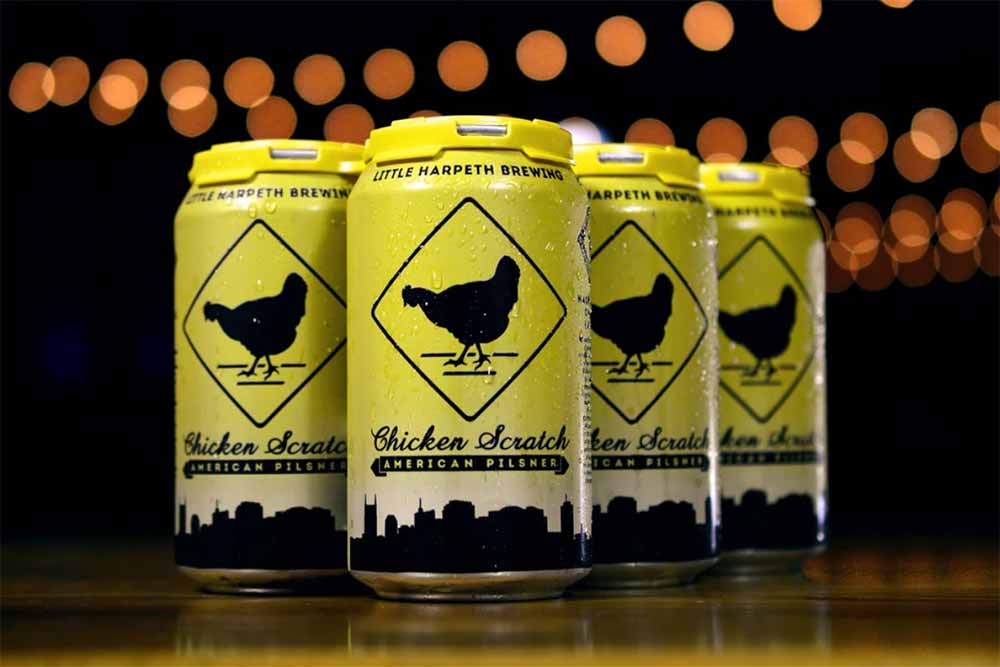
Photography courtesy of Little Harpeth
Here’s the easy answer: “America is really great at growing corn,” explains Liszewski.
Corn became a central component of any pre-Prohibition lager along with six-row barley versus the two-row barley more commonly found in Europe.
Because the enzymatic six-row barley is more stout with more kernels and a slightly higher protein content, the grain efficiently breaks down the sugars in the corn, meaning pre-Pro lagers have a “distinct, slightly corny flavor and this real richness from the six-row,” says Liszewski.”
Although traditional pre-Pro lagers may have included more corn in the grist bill, brewers today play around with what works well for them.
At East Brother, Liszewski says they’ve tinkered with as low as fifteen percent and as high as thirty percent, but twenty percent does the trick. “We dialed in the appropriate amount of corn flavor to keep everything in balance,” says Liszewski. “You want to taste [the corn] but don’t want it to be front and center.”
At Little Harpeth, whose Chicken Scratch pre-Pro lager the Beer Judge Certification Program (BJCP) lists as one of the best commercial examples, about ten percent of the grist is corn, according to Nic Donahue, VP of sales and operations at RS Lipman Brewing Co., which added the Nashville-based brewery to its portfolio in 2020.
For Goldfinger’s pre-Pro lager, Beckmann found twenty-five percent corn as the sweet spot.
“We wanted to make sure there was a fresh corn flavor,” he told us.
But it’s not just the amount of corn considered here that can develop flavor; it’s also what kind.
Part of This Complete Beer: Flaked, Grits, or Raw
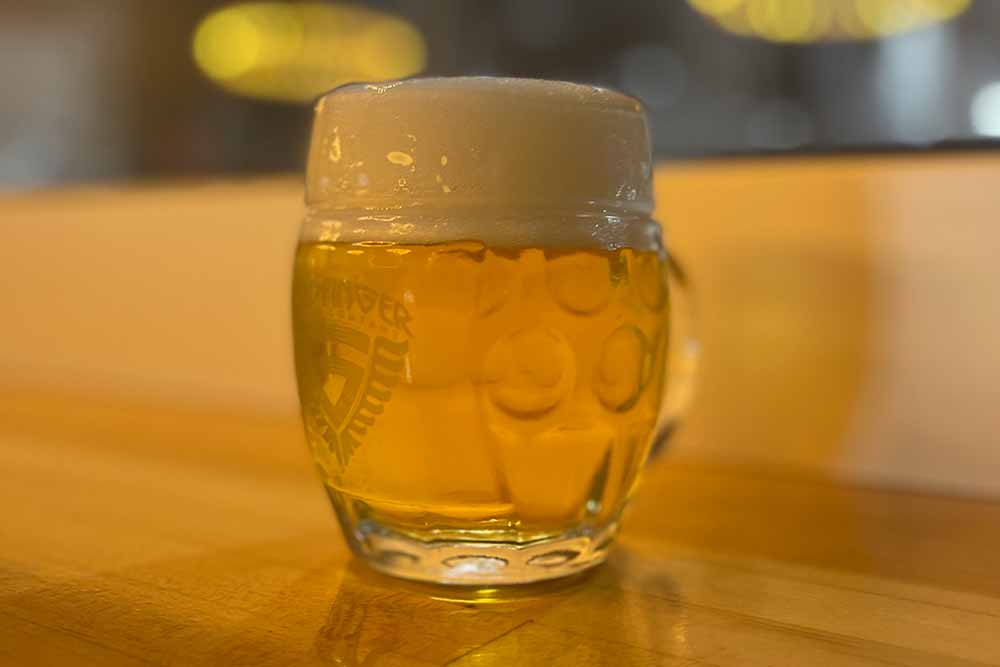
Photography courtesy of Goldfinger Brewing Company
Most likely, back in the day, brewers used raw corn in a pre-Prohibition lager. So that’s what Little Harpeth puts in its year-round pre-Prohibition lager.
“Maybe I’m a hopeless romantic, but I believe in things you can’t calculate,” Donahue shares. “There’s a certain nostalgia and romanticism [with raw corn].”
Donahue compares it to driving a 1920s Ford Model A versus a Tesla. With the former, “I’ve got grease under my fingernails, and the cab smells like gasoline. You can’t make that shit up!” he says. Whereas a Tesla may be more modern and sleek, it has none of that maudlinism of a classic.
Similarly, using locally sourced raw corn, Chicken Scratch taps into the terroir of that pre-Prohibition era.
Additionally, Donahue swears he tastes a significant difference. “There’s no other way to explain it; it’s just genuinely more corny,” he shares.
Similarly, at Goldfinger, Beckmann believes that the corn grits he uses add more freshness to the beer. “And a little bit more control over how corn plays a role in the beer,” he says. “What we found with some of the other corn products is that you still get some corn quality … but it can have almost a stale quality.”
Although bullish on these unmanipulated corns, Donahue and Beckmann admit challenges.
Obviously, these ungelatinized corn commodities contain a bunch of natural sugar, but unlike barley, this starch doesn’t have its own enzymes to change its complex starches into fermentable sugars.
The little kernel on the cob needs a little help from some friends.
Little Harpeth and Goldfinger need to implement an extra step called a cereal mash to tease out these crucial starches.
“We have to break down those sugars, and the only way to do that is by heating,” says Beckmann. “You boil the ungelatinized corn product … so that those starch molecules essentially start to explode and become simpler sugars.”
Little Harpeth actually added an additional tank just for this purpose. “We needed a fourth vessel in the brewhouse,” says Donahue. “A cereal cooker, which essentially steeps the corn prior to the addition to the mash.”
Think of it as showing up to a party with a bottle of wine and no opener. What would you do? Well, you’d ask your host for one, right? It’s the same idea here. While the raw corn or corn grits have the starch you’d want to add to a mash, it needs the barley’s enzymes to break those down into fermentable sugars for the yeast.
The cereal mash preps the corn to be like little dots for the six-row barley Pac-Man to gobble up.
Beckmann cautions that corn grits can have an additional hurdle. When you hydrate them, they can “become like mortar,” says Beckmann. “It’s super pasty and thick.” Not ideal to brew with, so Beckmann says they actually add a hint of malted barley into the grist (roughly half a twenty-five-kilogram bag) mixed in with the corn along with an enzymatic rest for the barley so “it can start doing its work and help mitigate some of that really thick kind of soupy water that’s created with the corn.”
Adding rice hulls can work, too, according to Beckmann.
For these reasons, it’s common to find pre-Pro lagers with an already gelatinized version of corn, such as flaked maize.
For most breweries, flaked maize hits that corny sweet spot without requiring an extra tank or cereal mash.
East Brother doesn’t have an adjunct cooker, so they include flaked maize, which Liszewski says has been very successful. “I don’t have to worry about the mash getting too sticky and making the brew day a really bad experience,” he explains.
Although this year, when Liszewski makes his seasonal pre-Pro lager in early spring, he plans to try a new malted corn from a local artisanal maltster called Admiral Maltings.
It’s the same place where Liszewski gets an heirloom six-row barley that he swears by.
Two, Four, Six, Eight! Who Do We Appreciate?
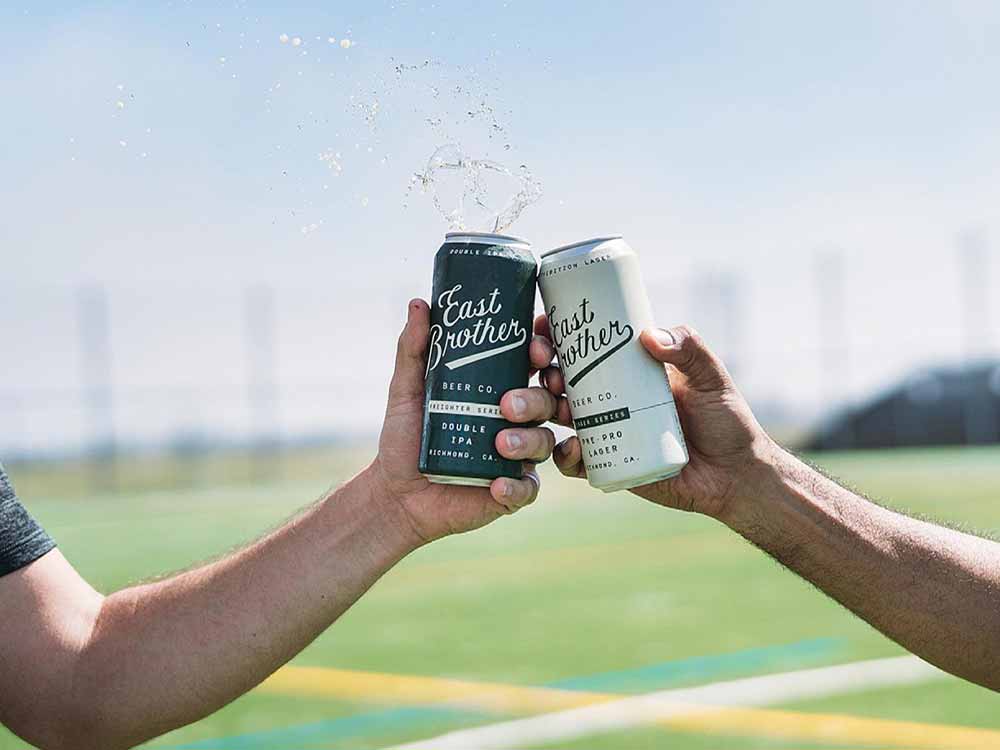
Photography courtesy of @eastbrotherbeer
Corn wasn’t America’s only readily available starch in the late 1800s and early 1900s.
“U.S. agriculture was growing a lot of six-row barley versus the two-row barley in Europe,” explains Liszewski.
Enamored with pre-Prohibition beer styles, Liszewski knew he wanted to make a pre-Prohibition lager as East Brother’s first rotational season. His first version included flaked maize and commercially available six-row barley from Rahr Malting Co.
The following year, a local artisanal maltster called Admiral Maltings approached Liszewski touting an heirloom six-row barley from a multigenerational California farmer.
Liszewski was one of the first brewers to try the entire first batch, Atlas.
“The amount of flavor you get from an extremely fresh malt was just eye-opening,” says Liszewski. “You could taste everything surrounding the field that helped pollinate the malt.”
Liszewski swears so much by that homegrown malt that when rain destroyed last year’s crop and the farmer refused to sell it, Liszewski decided to forgo making his seasonal pre-Pro lager. “I refused to go back to the previous malt because we would have lost so much flavor that made [the beer] unique,” he says. “I’d rather not do it and have people wait another year and do it right. I’m glad I did, and I know I’m going to have a lot of thirsty people come early May.”
Liszewski also feels a locally sourced malt stays true to the origin of pre-Pro lagers.
“When looking at beer and brewing one hundred years ago, the brewers had to rely on what was very close by to the brewery,” says Liszewski. “Every year, I’m trying to bring that circle a lot closer.”
Nowadays, most brewers generally use two-row barley when brewing because “it’s a much easier and better type of barley,” admits Beckmann, whose version of a pre-Pro lager gets fifteen percent six-row and sixty-percent two-row barley from a nearby Sugar Creek Malt. “But if we’re trying to be historical about it the best we can, we choose to include [six-row barley].”
In Hops We Trust
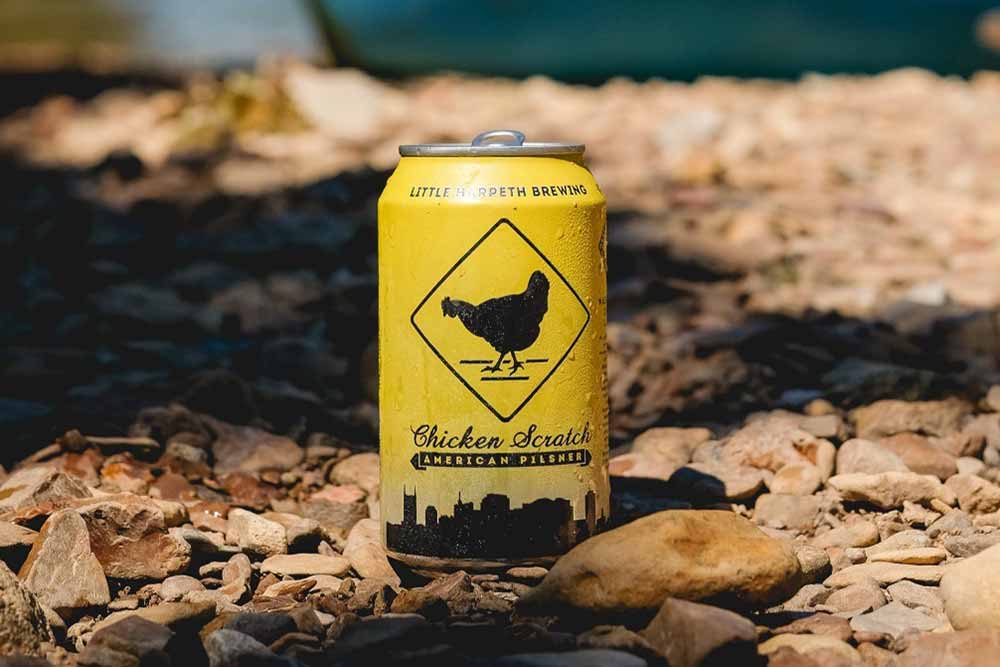
Photography courtesy of @littleharpeth
European lagers such as pilsner often present hoppier thanks to the use of Noble hops like Saaz, so you should expect pre-Pro lagers to drink with a distinct herbaceousness.
Albeit countered by that sweetness from the corn.
“Pre-Prohibition style beers tend to be a little sweeter because they have that corny characteristic,” says Donahue. “I think [the corn] essentially complements the hoppy characteristic.”
But hops are essential in these lagers.
Since pre-Pro lagers meld old-world brewing with new-world ingredients, these beers traditionally relied on (surprise, surprise) hops available at the time.
“If you look at what the U.S. produced hop-wise in the late 1800s and early 1900s, it was almost one hundred percent Cluster,” says Liszewski, who adds one hundred percent Custer hops into East Brother’s Pre-Pro Lager. “It’s a Noble-esque, spicy hop with its own unique character.”
At the Midwest-based Goldfinger, Beckmann leans into the idea of locally sourced. So, while he uses American-grown Fuggle hops, they come from a farm in a neighboring state. “The closest hops that we could get to Illinois to give us that kind of local terroir were from Michigan,” he explains. “We wanted to do it the way we thought was the right way: to get ingredients as close to our brewery as possible and do what was likely being done in the pre-Prohibition era.”
Beckmann says you shouldn’t “shy away from bitterness.” Pre-Pro lagers should have an assertive bitterness; otherwise, you’re getting into the land of light and macros lagers. “We wanted ours to have a nice hop presence,” he says.
Back to the Future?
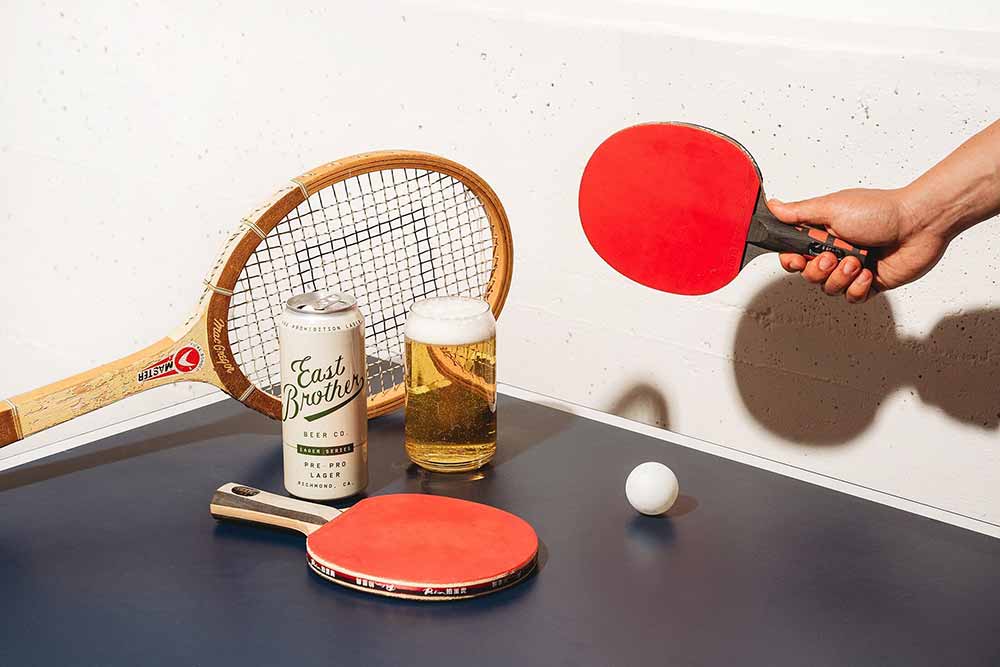
Photography courtesy of @eastbrotherbeer

Photography courtesy of @eastbrotherbeer
While pre-Pro lagers harken to the past, could they be harbingers of the beer industry’s future?
Since East Brother brewed its pre-Pro lager, we’ve personally seen at least two other breweries in the East Bay—Wondrous Brewing and Tenma Beer Project—experiment with their versions.
“I like to think maybe we had some influence!” says Liszewski, who admits the style at East Brother has grown over time with both seasoned craft beer drinkers and non-craft beer drinkers alike. “If you want a classic American flavor, then Pre-Pro fills that niche nicely.”
Similarly, Beckmann found that with Goldfinger’s Pre-Prohibition Lager, people love transporting themselves back to a different time.
Although Beckmann brewed Goldfinger’s pre-Pro lager as a one-off, he says people liked it enough to make it again next year.
While Beckmann won’t go so far as to say these beers are experiencing a renaissance, he hopes pre-Pro lagers can play a role in helping drinkers understand the diversity of lagers and “appreciate what American ingredients can do in the lager realm,” he says.
Donahue agrees. “We’re inventing new beers every day and always looking for something new, but in my sense, people are nostalgic,” he says. “I’m surprised more people don’t celebrate these throwback beers. … We should be celebrating because these are great beers.”
Over the past decade, Chicken Scratch has consistently ranked as one of the most popular best-selling beers in Little Harpeth’s Tennessee-based market.
Although Donahue admits, “While it’s a great beer, people still want the Tesla!”
So maybe pre-Pro lagers aren’t quite a Ford Model A or a Tesla, but it does seem like they’re fueling the DeLorean. For pre-Pro lagers where we’re going, we don’t need roads…just some American-grown six-row barley, corn, and hops.
Hop Culture’s Top Pre-Prohibition Lagers to Try
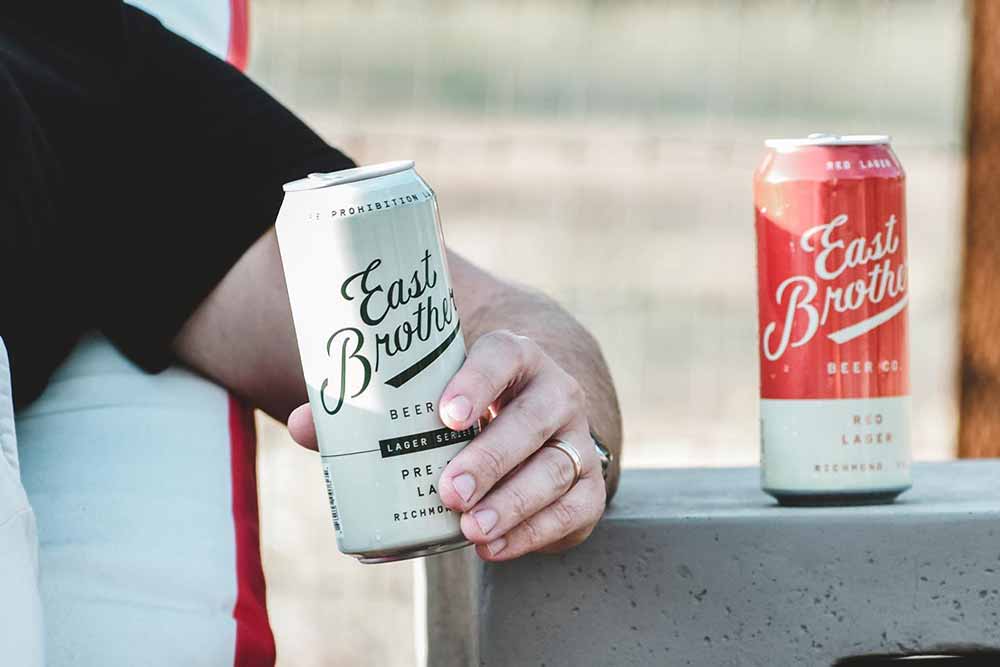
Photography courtesy of @eastbrotherbeer
Pre-Prohibition Lager – East Brother Beer Company

Photography courtesy of @eastbrotherbeer
Richmond, CA
Only available in the summer, Pre-Prohibition Lager stays true to the morals of this style using ingredients from as close as possible to the brewery as often as possible.
Appearance-wise, Pre-Prohibition Lager pours super bright and clear with a straw color. Liszewski says the protein in the heirloom six-room barley gives this beer “a really beautiful white frothy head.”
Flavorwise, Liszewski describes East Brother’s pre-Pro lager as “just enough corn with some nice spice and a little bit of English hop character, but still a Noble-esque spiciness,” he says. “The six-row [barley] shines through with a little bit of grass and honeysuckle, just a little bit of sweetness, and it finishes dry, crisp, and very effervescent.”
Although a bit higher on the ABV side for a pre-Pro lager at 5.2% ABV, Pre-Prohibition Lager “is a really easy-drinking, refreshing balanced beer,” says Liszewski.
Look for East Brother’s seasonal pre-Pro lager in May. Liszewski says for next year’s version, he’s hoping and excited to incorporate a new local heirloom corn.
Pre-Prohibition Lager – Goldfinger Brewing Company
Downers Grove, IL
Traditionally, Goldfinger focuses on clear, refined, European-style lagers. But secretly, Beckmann has always been fascinated by American lagers before macro breweries and Prohibition neutered them.
So you can see the appeal of brewing a pre-Pro lager. “We always look for an opportunity to explore a realm within the lager space that we might not be as familiar with and just kind of challenge ourselves as brewers,” says Beckmann. “And then there’s a little bit of dreaming that maybe if enough craft brewers start making very American-centric beers, we can kind of reclaim the style of an American lager.”
Goldfinger’s Pre-Prohibition Lager does just that.
Pale and clear from the fifteen percent six-row barley and twenty-five percent corn, this pre-Pro lager pours with a “very fresh, almost borderline cucumbery aroma, which I think was a combination of the more raw grains we used and also the American-grown Fuggle [hops],” says Beckmann. “It smelled so fresh, definitely enticing you to drink.”
With a middle-of-the-road body, Pre-Prohibition Lager seems simple on the outside but, like a stalk of barley or kernel of corn itself, complex on the inside. “It was like if we squeezed the earth on a barley and hop field, this is what came out,” says Beckmann. “It felt super authentic and tasted so different from most of our European lagers.”
Based on the popularity of Goldfinger’s pre-Pro lager, Beckmann expects to brew it again next year towards the end of the summer.
Chicken Scratch – Little Harpeth
Nashville, TN
Although categorized as a pilsner, Chicken Scratch is one of the iconic commercial examples the BJCP definition gives of a pre-Prohibition lager.
It has all the components of a pre-Pro lager: corn (raw corn!), six-row barley, and Saaz, Saphir, and Hallertau hops.
And it’s the only one we’ve found brewed year round instead of seasonally or once.
Like East Brother’s version, Chicken Scratch has exceptional head retention. Pouring with a darker golden hue, this pre-Pro lager has a nice viscosity and weight from the corn, according to Donahue. “It just has this pleasant texture that coats the palate.”
On the nose, you’ll find that predominant Noble hop aroma “leaps out of the glass,” says Donahue. “It’s not this super crisp, dry beer that just washes away. It lingers kind of in the most appealing way.”
Corn dominates in this pre-Pro lager, but the herbaceousness of the hops expertly balances it. “It’s got a good spice to it,” says Donahue.
Emery Beer – Wondrous Brewing Company
Emeryville, CA
With a bit different grain bill than others on this list—rye, spelt, rice, and barley—Wondrous’ pre-Prohibition lager also differs on the hops—Simcoe.
Still, we enjoyed Emery Beer on a recent visit to Wondrous.
You get stone fruit peach but also dank pine from the Simcoe on the nose, while a depth of cereal grains carries through the body of the beer.
Maybe not the most classical version, but still a bright, balanced, bitter pre-Pro lager.

